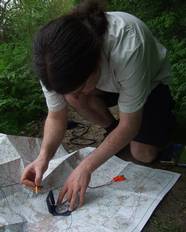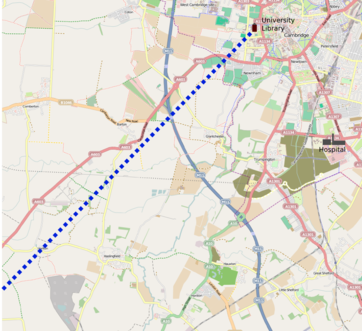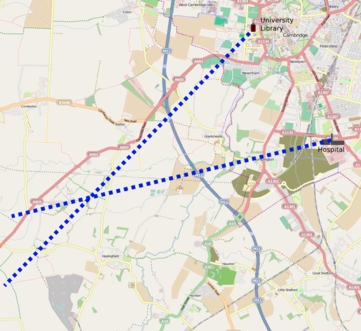Where am I? Finding your position by triangulation
Ingredients
| Somewhere with a view, and you are a bit lost | A compass | ||
| A map | A pencil |
Instructions
If you are wandering in the hills, or you are out at sea and you are no longer entirely sure of where you are you can use a compass to find out, as long as you have a map and you can regognise two objects on that map.

You are sitting on one point of a triangle with the two objects at the other points. If you know where they are and the shape of the triangle you can work out where you are. If you can find them on the map you know one side of that triangle, and if you know one side of a triangle and two angles you know the shape of the triangle. So:
 |  |
|---|---|
| Using a compass to find the bearing of the university library | Drawing the bearings on the map |
Use the compass to work out what direction the first of your objects is in. You can draw a line on the map of all the places which are in that direction.
One subtlety is that the compass points at the magnetic pole, not the actual north pole. This means that you have to apply a correction which changes depending where you are in the world, and the magnetic pole moves so the correction changes with time. We subtracted the 3.5 degrees which was indicated on the map.
 |  |
|---|---|
| The first bearing finds all the places which would see the library on a bearing of 38.5 degrees | The second bearing gives you another line of places where you could be. Where the lines meet should be where you are |
If you do the same for another object you will find two lines. You should be standing on both of these lines so you should be where they cross.
The accuracy will depend on how accurately you manage to take the bearings and transfer them to the map. In our case we were about 300m off, which wasn't bad considering we were taking bearings from buildings about 7km away. This would also have been improved if we had picked objects at more widely dispersed angles, as an error in the bearing will then produce less error in position.
- Previous DIY CD Hovercraft
- Next Rubens' Tube - waves of fire









Comments
Add a comment